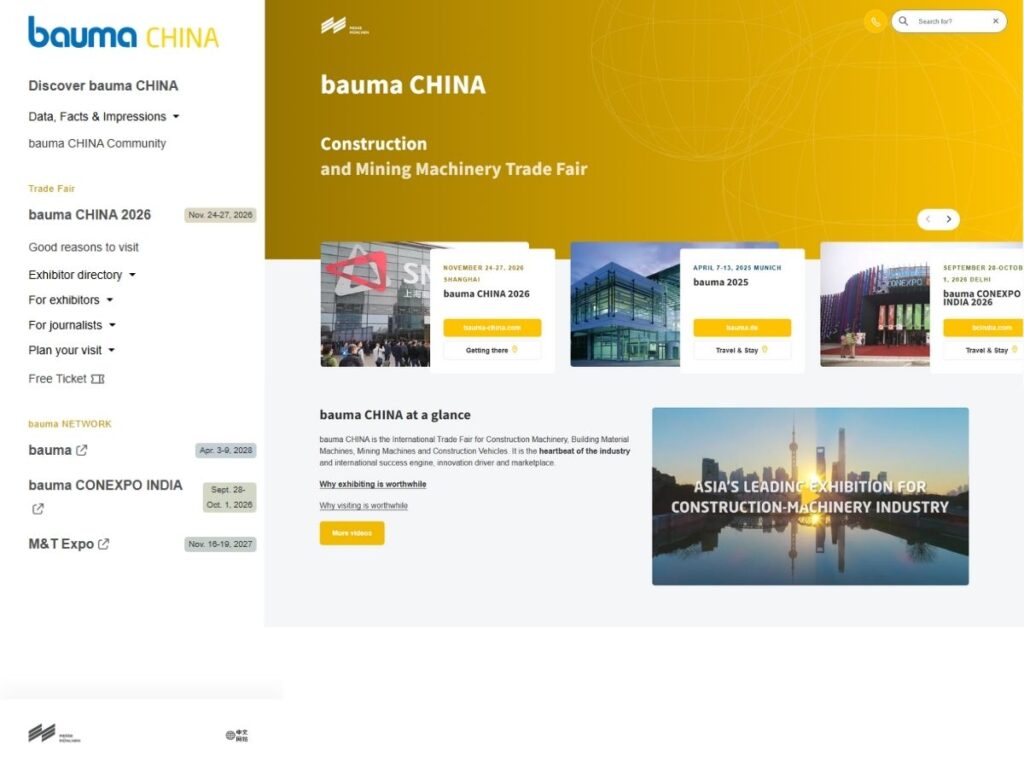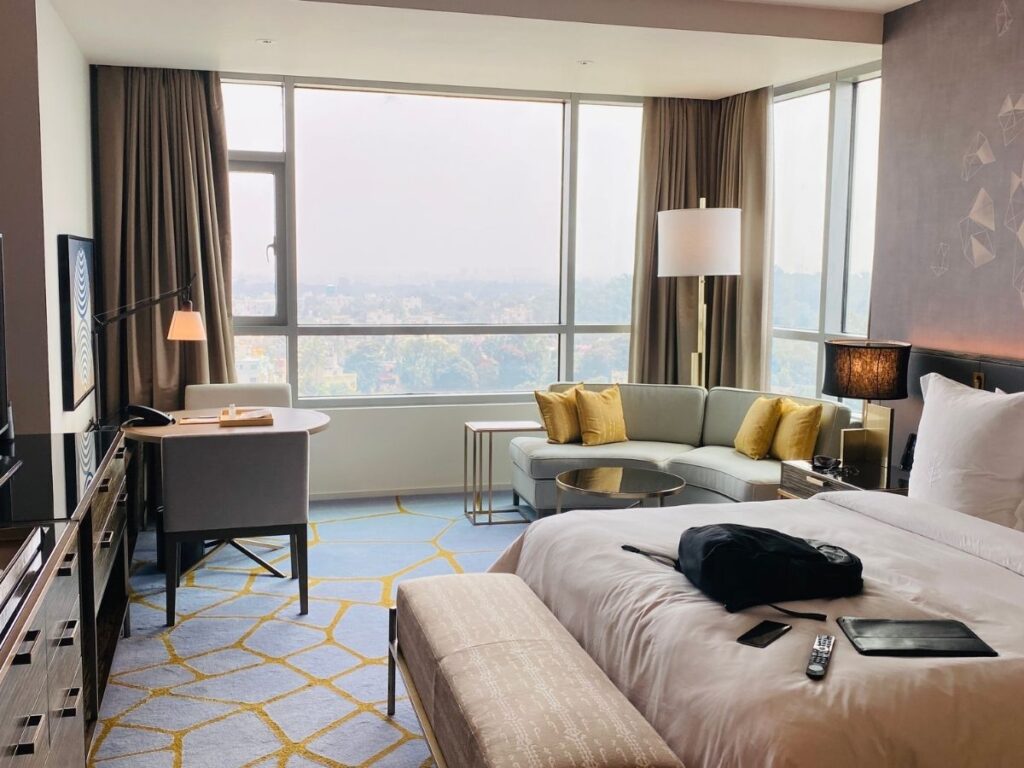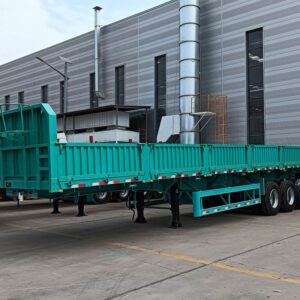I still remember my first visit to Bauma China, it felt like stepping into a small city made of machines. I had no real plan, just a few printed exhibitor names and a vague idea of what we were looking for.
After 3 days, I left with sore legs, a suitcase full of brochures, and the sinking feeling that we’d missed every real opportunity.
That trip taught me something every business owner should know: trade shows like Bauma aren’t just about showing up. You need a game plan. Since then, I’ve led 4 more visits, each time more focused and profitable than the last.
In this article, I’ll walk you through how to do the same. From choosing the right halls to planning meetings and avoiding rookie mistakes, you’ll get a step-by-step approach that helps your company gain actual value from Bauma China.
Whatever your industry, these tips will make your visit work for you.
Let’s dive in!
1. Pre-Event Planning
Let me be blunt: if you’re treating Bauma China like any other industry event, you’re already falling behind. This isn’t just a trade show. It’s a battlefield of global brands, serious buyers, and time-wasters all in one place.
And without a plan, you will get swallowed up by the noise.
Start with Your Business Goal
Before you even step foot in Shanghai, ask yourself:
- What do we want out of this event?
- Are we scouting suppliers? Vetting new tech? Looking for market intel?
- Who should we be meeting, and why does it matter to the business right now?
Don’t fall into the trap of “seeing what’s out there.” That kind of thinking is expensive.
I’ve done it. I’ve walked miles of the expo floor with no real objective. You know what I left with? A bunch of swag and no follow-ups. That year, I burned four days, and our competitors made real deals. Never again.
Choose 3–5 Strategic Outcomes
Here’s what works: define 3 to 5 specific outcomes that align with your business needs. Here’s what that might look like:
- Construction Companies: Evaluate 2–3 new OEM suppliers and compare demo performance.
- Manufacturing Teams: Identify automation tools that reduce downtime or staffing strain.
- Logistics and Fleet Managers: Scout smart tracking or route optimization tech.
- Procurement or Sourcing Leads: Pre-negotiate pricing with existing vendors face-to-face.
Involve the Right People Early
This isn’t a one-person mission. Bring in your technical leads, operations heads, or buyers during the planning phase. Ask them:
- “What are the top 3 things you’d want to see or learn at Bauma?”
- “What vendors or categories are we curious about, but haven’t pulled the trigger on yet?”
You’ll build a smarter visit when you plan as a team, even if only 1 or 2 of you attend.
2. Register Early and Prepare Documentation
Let’s get one thing out of the way: Bauma China is not the kind of event you want to “figure out later.”
By the time you’re reading this, thousands of companies have already started planning, and the smartest ones? They’ve already registered.
Where to Register
- Official Website:https://www.bauma-china.com
- Event Dates: November 25–28, 2025
- Event Venue: Shanghai New International Expo Centre (SNIEC)
Registration typically opens several months in advance, expect it to go live mid-2025. Bookmark the site, or sign up for email alerts.
Documents Needed
Whether you’re attending as an exhibitor, visitor, or sourcing rep, have your documents in order. Some may seem basic, but missing one can delay everything.
For International Visitors
- Business Visa (M visa): Required for most international attendees. You’ll likely need an official invitation letter from the event organizer. Start this process at least 4–6 weeks before your flight.
- Company Business License or Proof of Employment: Some consulates ask for it when processing your visa.

3. Choose the Right Accommodation
Here’s something you won’t find on the event site: your hotel choice can make or break your entire Bauma China experience.
I’ve stayed too far. I’ve stayed too close (yes, there is such a thing). I’ve dealt with zero taxis, no Wi-Fi, and once, no hot water during winter. Never again.
Here’s the rule: Proximity + Comfort + Business-Friendly = The Win
You’ll be on your feet 10–12 hours a day. You’ll have meetings, product demos, and logistics to manage. You need a hotel that works as hard as you do.
Where to Stay
- Near SNIEC (Walking Distance) – Pudong District
Pros:
- 5–15 minute walk to the venue
- Easy mid-day breaks or meetings
- Perfect for multi-day access
Cons:
- Prices spike fast — these book up 3–5 months in advance
- Limited food/nightlife options nearby
Top Picks:
- Kerry Hotel Pudong (5-star, connected to SNIEC)
- Jumeirah Himalayas Hotel
- Dorsett Shanghai
- Lujiazui or Century Park Area (Business + Comfort Combo)
- 20–30 minutes by taxi or metro
- Ideal if you want good restaurants, business lounges, and comfort after a long day
- More options for hosting informal meetings or dinners with suppliers
Top Picks:
- Grand Kempinski Hotel Shanghai
- Park Hyatt Shanghai
- InterContinental Shanghai Pudong
- City Center (For Extended Trips or Leisure Time)
- Stay here only if you’re combining Bauma with other business in Shanghai
- Commute will take 40+ minutes each way — doable, but not ideal for daily show visits
What to Look for in a Hotel
- Wi-Fi that actually works (don’t assume, check reviews)
- Business center access or meeting rooms
- Early breakfast service (Bauma days start early)
- Staff who speak English (saves time and frustration)
- Proximity to Metro Line 7 (Huamu Road Station) if you’re commuting
Booking Mistakes to Avoid
- Waiting too long. Good hotels sell out quickly for this event, especially near SNIEC.
- Assuming “luxury” means “business ready.” I’ve stayed in high-end hotels where printing a single PDF took 45 minutes.
- Booking too far out for a cheaper rate. You’ll lose valuable hours in daily transport, time that could’ve been spent networking or closing a deal.

4. Know the Layout
Let me save you from making one of the most common (and costly) mistakes at Bauma China: Winging it.
This show is massive. We’re talking about more than 300,000 square meters of exhibit space across indoor halls, outdoor demo areas, and themed zones, all packed with heavy machinery, tech, and thousands of visitors moving in every direction.
On my first visit, we spent Day 1 just trying to figure out where things were. No meetings. No deals. Just a lot of walking and asking people for directions.
By Day 2, we had a printed floor plan and a list of booths, and the difference was night and day. Plan first. Walk second.
Breakdown of the Venue
Bauma China takes place at the SNIEC (Shanghai New International Expo Centre), a sprawling venue with:
- 17 indoor halls (W1–W5, E1–E7, N1–N5)
- Multiple outdoor exhibition areas
- Designated demo zones (yes, machines are running live)
- Connected by long corridors and wide walking paths
Venue Address: 2345 Longyang Road, Pudong, Shanghai
Hall Overview
Here’s a general breakdown (subject to annual updates, so always confirm before arrival):
- W Halls (W1–W5): Heavy Machinery, Earthmoving Equipment, Concrete, Road Construction
- E Halls (E1–E7): Components, Systems, Powertrain, Hydraulics, Drivetrains, Industrial Tech
- N Halls (N1–N5): International Brands, Digital Construction, Smart Systems, Software, Startups
- Outdoor Areas: Live demonstrations, large-scale equipment, test drives, crane and haulage displays
Use Tools
- Download the official Bauma China app. Use it to:
- Search exhibitors by category or name
- Pin booth locations
- Navigate the halls in real time
- Receive alerts on live demos or seminars
- Print a hard copy of the floor plan anyway. Wi-Fi can be spotty in crowded areas — always have a backup.
5. Maximize Networking
Let me say this clearly: You don’t go to Bauma China to collect brochures. You go to collect opportunities. Relationships. Strategic partners.
But if you’re not intentional about it, you’ll leave with nothing more than a full tote bag and a few forgettable handshakes.
Start Reaching Out Weeks Before the Event
If you wait until you’re walking the floor to start networking, you’re already late. Here’s what works:
- Identify high-value exhibitors or contacts that align with your goals
- Reach out via email, LinkedIn, or Bauma’s exhibitor directory
- Set up pre-scheduled meetings for coffee, booth visits, or private demos
The best conversations happen when people know you’re coming.
Be Clear About Why You’re Reaching Out
Don’t just say, “Let’s meet at the show.” Say something like:
“We’re evaluating new suppliers in the [specific] category and noticed your latest
. I’d like to stop by your booth on Day 2 and discuss how it might fit into our current sourcing strategy.”Short. Direct. Professional.
Attend Forums and Side Events With a Purpose
Bauma China isn’t just a showroom, it’s a knowledge hub.
There are panels, forums, and invite-only mixers happening every day.
Choose 1–2 that directly connects to your industry segment or strategic interests. These are your opportunities to meet decision-makers, not just booth staff.
After the talk, don’t just leave. Stick around, introduce yourself to the speaker or panelists, that’s where the real value is.
Come Prepared
This might sound obvious, but I’ve watched business leaders show up with nothing more than their phone. Here’s what your team should carry:
- Printed and digital business cards
- A brief company intro (printed or QR)
- Portfolio or product sheets (PDF format on your phone or tablet)
- A polite, practiced elevator pitch, tailored to who you’re speaking to
You don’t need to oversell. You just need to make it easy for the right people to follow up with you.
Take Notes
You’ll talk to dozens of people in a day. If you think you’ll remember them all, you’re wrong.
Right after every meaningful conversation:
- Write down who they were
- What you discussed
- What the next step is (if any)
Use your phone, notebook, or even a voice note. Just do it. Your follow-up strategy depends on it.
6. What to Watch for in 2025
Every year, Bauma China becomes a snapshot of where the industry is going. But in 2025, it’s more than that, it’s a reality check.
The market’s tighter. Competition’s fiercer. Technology is moving faster than most teams can adopt. If you’re walking into this event, you need to know where the industry is headed, and what to pay attention to before your competitors do.
Digital Tech in Heavy Equipment
From AI-guided excavation to autonomous haulage systems, digital integration is everywhere. Watch for:
- Smart machine controls and real-time jobsite data tracking
- Fleet management tools that reduce fuel use and downtime
- Remote operation systems for dangerous or isolated environments
This isn’t future-speak anymore. It’s happening — and companies using it are already ahead.
China’s Manufacturing Push
Chinese equipment makers are no longer just the “affordable option.” They’re bringing serious innovations, aggressive pricing, and smarter global support. What to look for:
- Local brands offering high-performance equipment at 60–70% the cost
- Improved after-sales networks for international buyers
- Integrated control systems that rival German and Japanese tech
If you’re sourcing, don’t overlook the mid-size domestic brands. Some of them will be global players within the next 2 years.
Green Is No Longer a Buzzword — It’s a Competitive Edge
Sustainability is being baked into product design, especially in Europe and Asia. Key things to spot:
- Electric and hybrid machinery for urban environments
- Low-emission engines that meet evolving global standards
- Materials and parts designed for end-of-life recycling or circular economy use
If your projects are in regions with tightening environmental rules, this is no longer optional.
7. Post-Event Follow-Up
The show might be over, but your real work is just beginning.
Because what you do in the first week after Bauma China will determine whether this trip added real value to your business or just looked good on LinkedIn.
I’ve made the mistake of coming home, dumping my business cards into a drawer, and telling myself I’d follow up “next week.” That next week turned into never, and we lost a supplier to a competitor who moved faster.
Sort and Prioritize Your Contacts
Right after the show, carve out a half-day to clean up your notes and materials. Don’t just leave it to memory.
Here’s what works:
- Group contacts into three buckets: high-potential, follow-up later, no fit
- Tag each contact with key info: what you discussed, product interest, potential timeline
- Sync notes with your CRM or shared team doc, so nothing gets lost
If you bring a team, debrief together. Share what each person saw, who they met, and what actions to take next.
Send Smart, Timely Follow-Ups
Don’t send a generic “great meeting you” email. Send something that keeps the momentum going:
- Reference your booth visit or product demo
- Ask a specific follow-up question or request a proposal
- Mention your timeline or project window (if applicable)
Example:
“It was great to see your live demo of the hybrid crane at Bauma. We’re currently sourcing for Q1 2026 projects — can you send over spec sheets and pricing details by next week?”
Quick. Clear. Professional. That’s how you stay top of mind.
Evaluate Offers Before You Commit
Some suppliers will hit you fast with post-show “event pricing.” Before signing anything:
- Compare specs across similar vendors
- Loop in your technical or procurement team
- Don’t just go for the best deal, go for the best fit for your workflow, support needs, and growth plans

8. Bonus Tips for a Smooth Experience in the Fair
There’s what you plan, and then there’s what actually happens on the ground. Bauma China is intense. It’s crowded. It’s loud. It moves fast.
And if you’re not prepared for the small things, they’ll slow you down. So here’s what I wish someone had told me before my first visit:
Pack for Utility, Not Style
- Comfortable shoes are non-negotiable. You’ll be walking 10,000+ steps daily, no matter how tight your schedule looks on paper.
- Bring a lightweight backpack or shoulder bag. Not all booths offer totes, and you’ll collect plenty of samples and brochures.
- Carry a portable power bank, your phone will be your map, calendar, translator, and camera all day long.
Get the App and Use It Before You Arrive
- Download the Bauma China official app early.
- Bookmark your must-visit booths.
- Set up reminders for demos or sessions.
You don’t want to be figuring this out at the entrance with spotty Wi-Fi and a line behind you.
Don’t Count on Stable Internet
- Wi-Fi in the halls is unreliable when crowds peak.
- Buy a Chinese SIM card or pocket Wi-Fi at the airport, or make sure your international roaming plan is set up and tested.
- If you need access to services like Google, Gmail, or WhatsApp, you’ll need a VPN. Test it before you leave.
Use Translation Apps, Even If You Speak Some Mandarin
Most signage is bilingual, but not all staff are fluent in English, especially at smaller booths.
I use Google Translate or Baidu Translate with camera scans and voice features. They’ve saved me from multiple awkward product demos.
Conclusion
I walked into my first Bauma China unprepared and paid for it in wasted time and missed deals. Now, with the right plan, we close more, connect better, and walk out with real results.
This guide walks you through planning ahead, registration, hotels, layout, networking, tech trends, and follow-up.
Start planning now. Block time. Rally your team.
Your business deserves more than just another trade show.
Need help mapping it out?
Contact us today, we’ll walk the floor with you.



